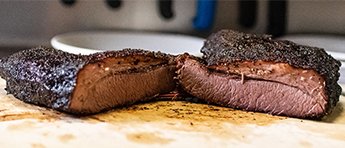Barbecue, barbeque, bar-b-q, BBQ – no matter what you call it, there’s no question about the level of flavour this method delivers. To dive into the basics of smoking beef, we sat down with Sterling Silver® Premium Meats customer Tim Keegan, Executive Pitmaster of Fiorella’s Jack Stack Barbecue. Tim was born into this cooking method – as his family owned a barbecue restaurant in Kansas City. He first learned to trim down brisket at age 14.
Barbecue, a method that requires live fire and smoke to cook and flavour food, is a timeless and rustic preparation style. Smoking works wonders on larger cuts like brisket, roasts, and racks of ribs. “Always start with a quality piece of protein,” says pitmaster Tim. He loves working with Sterling Silver brisket in the smoker for 12 hours, or a couple of Sterling Silver ribeyes on the grill.
While cold smoking is used to cure proteins, hot smoking is all about adding flavour to a cut. These flavours derive from all aspects of the process – the wood chips used, the amount of time in the smoke, and the amount of seasoning used. Pitmaster Tim always uses dry chips at Jack Stack Barbecue, with a mix of oak and hickory wood chips. “I tend to stick more to the heavy woods like hickory, pecan, and walnut when smoking beef.”

Proper airflow is key to maintaining ideal temperatures when using barbecue preparations. According to pitmaster Tim, “blue smoke is the key.” Blue smoke is the point when the combination of heat, oxygen, and fuel is ideal. Maintaining a consistent temperature will ensure the cuts deliver their signature barbecue tenderness and flavours – too high of temperatures can sacrifice those qualities and over-smoke the cuts.
For beginners developing their craft, pitmaster Tim has the advice to get you started. “Take your time, write your processes down, and only change one thing at a time.” Since no fire is identical, pitmasters learn how to read the signs – and the smoke – to achieve signature barbecue tenderness. Once you find a rhythm with your processes, all kinds of comfort foods, from nachos to sliders, can delight your customers and become new favourites.


Follow us for more great inspiration
Get the Goods
Our Podcast
Listen & SubscribeHosted by Chef Pete Geoghegan